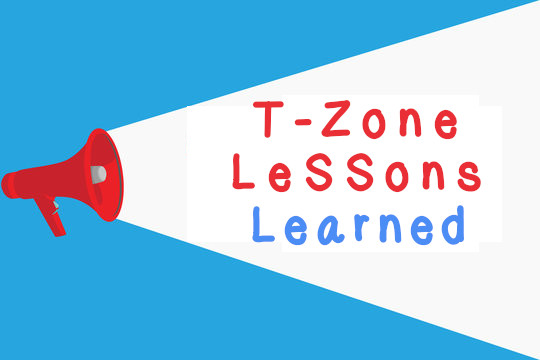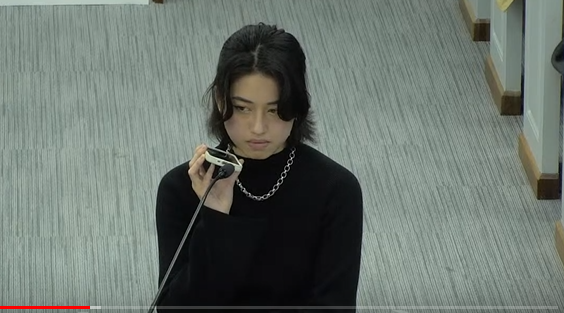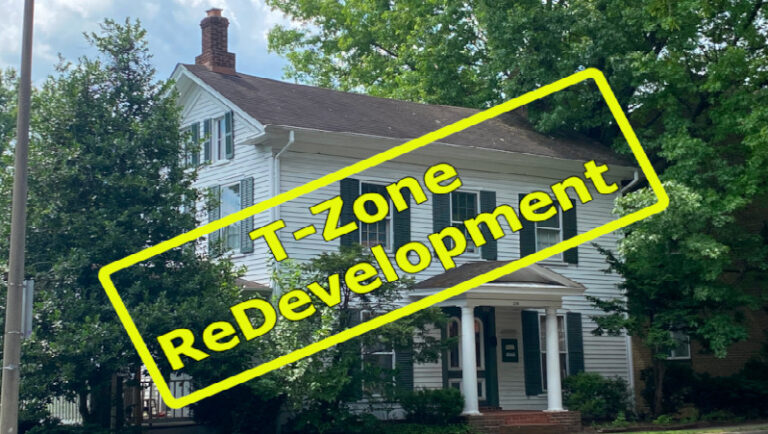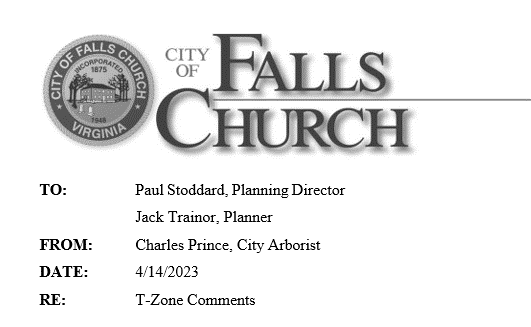T-Zone Lessons Elected Officials and City Staff Plan To Apply To Future Zoning Changes
A month after the Falls Church City Council’s 5-2 approval of a new zoning ordinance governing the T-1 transitional district (T-Zones) in September 2023, the Council’s Government Operations, Administration, and Evaluations Committee met to consider how the two-year process could have been better managed.
City Council members and staff concluded at their October 24, 2023, “after action” meeting that future major zoning changes need to be guided by “top-down direction from Council” while acknowledging the potential benefit of more “bottom-up listening” to citizens. They discussed the need to declare and explain the “why” behind any proposed policy changes and to define how citizens can expect to be engaged in the process.
“We got exposed on this”
Their discussion confirmed what citizens had perceived to be a flawed process. The committee’s discussion revealed that the T-Zone effort began behind closed doors, lacked clarity of public purpose, and was initially understaffed, leading to the production of multiple iterations of a policy that changed repeatedly.
The final ordinance adopted on September 26, 2023, “didn’t look anything like” the initial ordinance referred out to select City boards and commissions on May 23, 2022, also on a 5-2 vote, according to City Manager Wyatt Shields. “We got exposed on this,” he said toward the end of the hour-long meeting, acknowledging mistakes in his personal handling of staffing on the T-Zone initiative.
The conversation, chaired by then Vice Mayor Letty Hardi, was attended by Council Members Marybeth Connelly, Phil Duncan, and Debbie Schantz-Hiscott as well as Mr. Shields, Planning Director Paul Stoddard, Planner Jack Trainor, City Clerk Celeste Heath, Deputy City Clerk Veronica K. Prince, and Public Meetings Assistant Sophie Kachur. The meeting was guided by a memo titled T-Zones Takeaways: Considerations for Improving Public Engagement and authored by Mr. Trainor and Mr. Stoddard.
T-Zone lessons learned
Based on the T-Zone experience, the staff memo identified five areas for improvement:
- Clarity of public purpose: Clearly articulating public purpose and policy goals from the City Council while engaging public concerns.
- Adequate staffing: Ensuring that sufficient staffing is in place for the required level of engagement and project complexity throughout the process using teams built from several City departments, including Communications.
- Public engagement plan: Defining what staff and the City Council determine are the appropriate levels and channels for public engagement at the beginning of projects.
- Outreach toolkit: Informing and engaging the public using a suite of tools, such as yard signs, glossaries of terms, project webpages, community frequently-asked-questions (FAQ) documents, informational videos, and responses to false information in the same medium in which the misinformation originally appeared.
- Staff report format: Revising the planning staff’s reports to add a table of contents for longer reports and clearly identifying the City’s legal authority to act, as well as the relevant legal tests and the public purpose and policy goals the City Council has articulated.
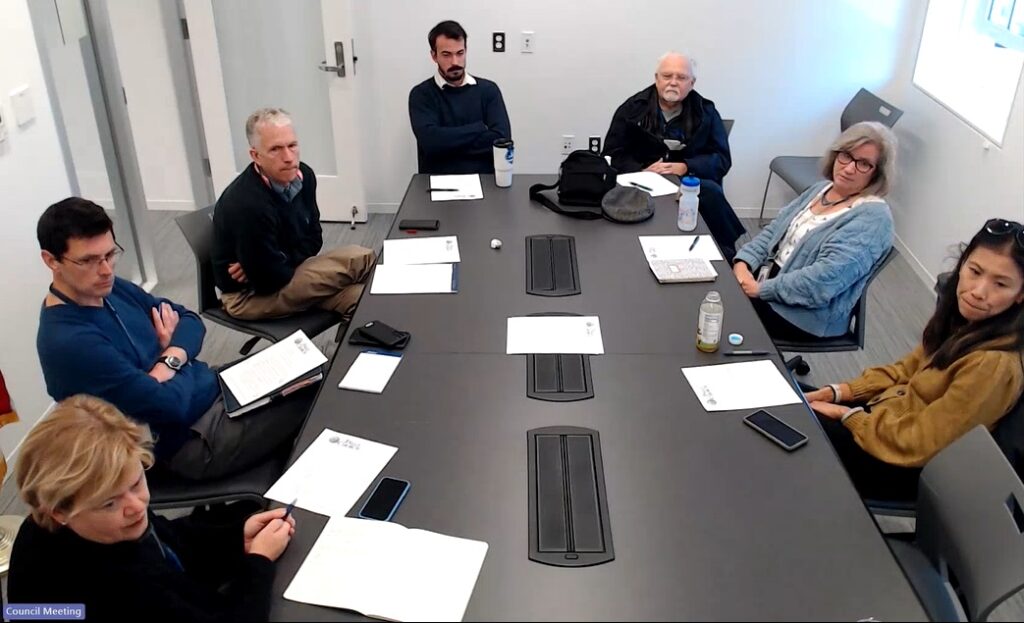
From the top
The group ultimately agreed that the public purpose needs to come from the City Council and must be restated throughout the process. They did not consider the possibility that a more democratic, bottom-up governance model might lead to greater community acceptance than a more autocratic, top-down approach.
Ms. Hardi noted that “somewhere along the way, we lost the idea of small infill development,” which she said was the original goal of revamping transition district zoning. “We received a lot of feedback that this was way too top-down, but you need the top-down policy objective, [and] that’s our job. …[W]hat was missing along the way is we set the top-down part of [T-Zones], but earlier on we should have done the bottom-up listening,” she said. “I don’t know if we’re asking for agreement…maybe it’s more informing how we are going to do this…how we’re going to achieve that goal,” Ms. Hardi continued, concluding that such policy initiatives “need a thrust from [the City Council].”
While Mr. Duncan believes “clarity of purpose is desirable,” he also said, “that purpose is linked to what the community will accept,” and “what can I get four votes to do? You have to push people who are just reluctant to change, which is always going to be a substantial minority in the City of Falls Church,” he stated. Where T-Zones are concerned, Mr. Duncan acknowledged that “people think differently. Some people want Park Avenue to stay the same; others of us want to see four-to-five-story condos and townhouses. It’s a lot to put on [City] staff to bridge that gap.”
Ms. Hardi replied, “Early on, we need to educate [the community] on the why and [explain] how the process will go. …What the community will tolerate…can evolve depending on what people want.” Mr. Duncan said, “People don’t know what they want,” and Ms. Schantz-Hiscott rejoined, “It’s our job to suss out what the public wants.”
How the T-Zone proposal got started
Mr. Shields indicated that the “very closed discussion” at an Economic Development Committee meeting in 2021 among Ms. Hardi, Mr. Duncan, and former Council Member Ross Litkenhous initiated the T-Zone effort. Regarding public engagement at the ‘why’ phase of any project, “You’re saying let’s open that up?” he asked the meeting attendees. Council Member Connelly responded “yes”, because then members of the public “don’t come up with the why and get three steps ahead of us and create [their] own why.”
How people get radicalized
Ms. Connelly maintained that the T-Zone effort was always meant to be an iterative process. However, when that process took too long, “the community grabbed onto and panicked about [elements of the rezoning proposal] and then that took on a life of its own in a way that nobody ever intended.” Members of the public “hated” the draft T-Zone ordinance before it had a chance to develop, she said.
Ms. Connelly likened this “process of radicalizing people” on T-Zones to what she has seen happen with other controversial issues. “It start[s] out with a stumble [by the City], and then people read some information and assume the worst and get other people involved and [tell] them the worst, and then there’s a petition, and then there’s a group, and then there are people coming to public meetings, and the staff have to spend all this time sifting through [public comments],” she said.
The Government Operations Committee agreed that the City’s boards and commissions should be brought in early through representatives at internal staff discussions and in early Planning Commission work sessions. They rejected the idea that sending a matter to these bodies effectively signals the City Council’s approval of it. Instead, “we should empower them,” Mr. Duncan asserted of the work of these advisory groups.
Ms. Connelly also favored earlier input from key staff members. With T-Zones, she noted, the City Arborist’s opinion on the zoning changes and their impact on a healthy tree canopy wasn’t sought until midway through the second year of the process. The Arborist’s statement expressing concerns about the consequences of the draft policy was cited repeatedly by its opponents. Had the Arborist been included in the discussion from the beginning, she suggested, his opinion might have been considered and moderated, preventing his April 2023 statement from being “used as a community cudgel” against the planning staff and those on Council supporting the T-Zone changes.
A lost year
Mr. Trainor said that projects like transition district rezoning require internal teams to accomplish. “Yes, there needs to be a case planner, someone that ties it all together, who shepherds it through,” he said, “but there really needs to be a whole team, a support system because one person can’t just do this alone.”
City Manager Shields owned this T-Zone failing, saying, “Paul [Stoddard] was telling me, ‘This is really awkward; we’re coming out with really half-baked things. We don’t have the staff.’ And I had this notion of [just] keep it simple.”
Mr. Stoddard confirmed that for that first year, “we were doing the [staff reports], but we weren’t actually doing any of the work.” It was when Mr. Trainor came on board that “we actually started doing research into other zoning ordinances, we started reviewing urban design, we started [calling] contractors, builders, developers. That’s when the Small Area Plan and [Comprehensive] Plan analysis got done,” he said.
The City Council members present concluded that going forward, more time needs to be spent on the public purpose, scope of effort, required staffing, level of public engagement, and timeline of all zoning and other projects included in the Council’s annual agenda. “If the work plan isn’t workable, it isn’t useful,” said Ms. Schantz-Hiscott.
“We would be unanimous in being disciplined about the work plan,” Mr. Shields said. “We want a work plan that is feasible.” He added, however, “If I’m giving you bad news [that] we’re not staffed for this right now, you…can still say, ‘We hear you, but charge ahead, figure it out.’ We’ll do the best we can. But just know that’s what we’re going to be doing.” On T-Zones, Mr. Shield said, “I have a tendency probably to mask that and try to sort of fake it until we get staffed up, and that was a mistake. …The whole first year was not well spent.”
Levels of engagement and staff reports
In engaging the public, members of the Government Operations Committee suggested that the level of public engagement should fit the number of people who are affected by the policy change. They favor the use of yard signs and videos and plan to respond to “false information in the same medium (e.g. Falls Church News-Press ads).” Plans for two-way dialogue between policymakers and the public as a means of engagement were absent from the planning staff’s memo and the committee discussion.
The format of planning staff reports also remained undecided at the close of the meeting. T-Zone staff reports ultimately totaled 100 pages each time they were issued. Mr. Stoddard eschews creating executive summaries, “because you write the same report twice.” Instead, he prefers to point different audiences to sections of the report most applicable to them. City Clerk Heath suggested that each report include “a one-pager describing what has changed” since the last time the report was issued. Tables of content were deemed useful for finding information of interest in reports.
A 2024 focus on accessory dwelling units
Looking ahead, Ms. Schantz-Hiscott, who as of January 8, 2024, is Vice Mayor, emphasized that the majority of the City Council wanted the T-Zone issue in their work plan in 2022 and 2023, and she favors addressing so-called “missing middle” housing in Council’s agenda for the new year.
Ms. Hardi, who is now Mayor, noted that “we’ve done cottages and T-Zones. [Accessory dwelling units] seem like the next [zoning issue]” to tackle. It is her goal to complete this and work like it within one year.
References
- ”T-Zones Takeaways: Considerations for Improving Public Engagement.” October 23, 2023. Staff memo to Government Operations Committee.
- Video of Government Operations Committee meeting, October 24, 2023.This official video recording will not display properly on mobile devices because it contains an agenda attachment.
- Video of Government Operations Committee meeting, October 24, 2023, https://youtu.be/h92qJCvDKP8

